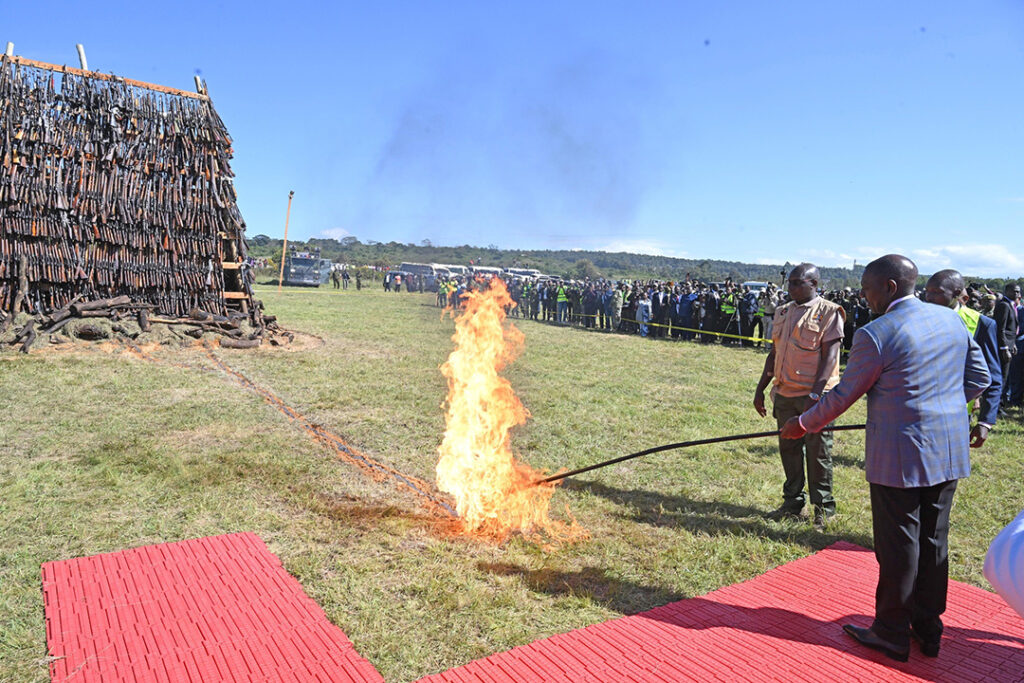With one tap of a torch, Kenyan President William Ruto set ablaze a huge stockpile of firearms at the National Police Leadership Academy in Ngong on June 13. The weapons were either surrendered under amnesty programs or seized in security operations.
The event also marked the 20th anniversary of the Regional Centre on Small Arms and Light Weapons, a United Nations-funded partner organization that coordinates disarmament efforts across 15 countries in the Great Lakes and Horn of Africa regions. A leader in small arms and light weapons (SALW) control on the continent, Kenya has disposed of nearly 40,000 illegal firearms in the past two decades. A new U.N. initiative is trying to further empower the concept of community-led SALW control.
“A firearm in the wrong hands is not just a potent weapon — it is a direct assault on the safety of our citizens, the stability of our society and the peace we have worked so diligently to build,” Ruto said. “We will not allow violence to take root in our communities.
“I commend both our security agencies and responsible citizens, including religious and community leaders, whose civic-mindedness and patriotism have made this national milestone possible. Because of their efforts, our families, communities and nation are safer.”
Political and social instability have plagued the Great Lakes and Horn of Africa regions for decades, creating space for an explosion of illicit small arms and light weapons. This proliferation has exacerbated conflicts and hindered interventions to restore peace and security.
The United Nations Institute for Disarmament Research (UNIDIR) recently launched the Community-Led Arms Control (CLAC) initiative to integrate arms control measures into peace-building and armed violence reduction efforts at the community level.
“The initiative seeks to support local actors in co-designing context-specific measures that link arms control with tangible improvements in community security and development, fostering trust, accountability, and shared responsibility between the communities and State institutions,” UNIDIR senior researcher Fiifi Edu-Afful wrote in an October 13 article.
Top-down disarmament programs are not as sustainable as local efforts, he argued.
“In some cases, civilians retain weapons for perceived self‑defense,” he wrote. “In others, they mistrust state protection or fear being left vulnerable to attacks from state security forces and non-state armed entities if they surrender arms. Understanding these failures requires looking beyond national frameworks to the local security dilemmas that compel communities to view arms as essential to survival.”
The new initiative is working to compile a toolbox of options to support communities in managing weapons while preventing proliferation, misuse and human suffering. Edu-Afful suggested some of the potential tools:
- Community-level weapons and ammunition management such as local registration, recordkeeping and safe storage
- Arms control trust and confidence-building mechanisms among communities, including telephone hotlines and information sharing on weapons holdings
- Early warning, prevention and response to deal with the movement of arms with community monitors for illicit weapons flows as well as the integration of arms control into local conflict mediation
Community and religious leaders, elders, women and young people should be included in decision-making, Edu-Afful said, supported by technical, legal and financial assistance from state and international partners.
“It is time we listened more closely to those living at the frontlines of armed violence; time to empower them to be the architects for safer, more just communities,” he wrote. “A community-led arms control approach can build on existing community experiences to design and lead innovative strategies to reduce armed violence that go beyond traditional disarmament and demobilization approaches in the peace-making and peacebuilding toolbox.”

